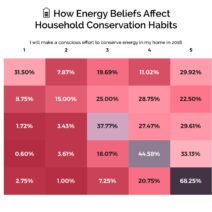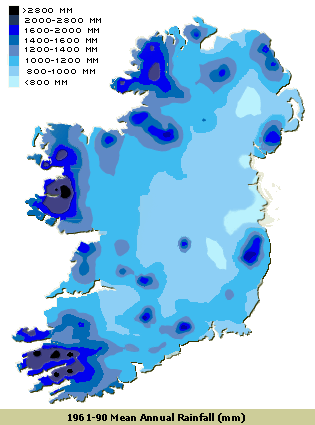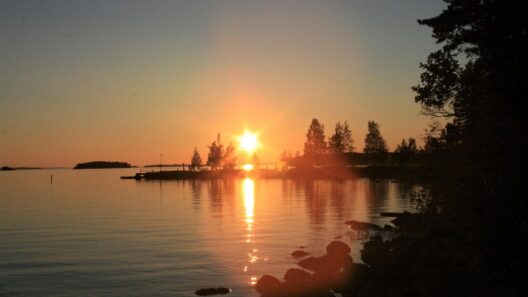Nestled on the western fringe of Europe, Ireland boasts a climate that could enchant the most discerning of travelers. But what truly defines the atmospheric character of this island nation? Is it the voluminous rainfall that seems to dance like confetti from the heavens, or the temperate breezes that provide a gentle caress through the verdant landscapes? As we delve into the nuances of Ireland’s climate, one might ponder: can one really cherish a land where rain falls in abundance, and how might that affect the enchanting scenery that Ireland is renowned for?
At first glance, the climate of Ireland is characterized as maritime temperate, which is a polite way of saying that it is predictably unpredictable. The island is ensconced by the Atlantic Ocean, which mediates extreme temperature fluctuations. This maritime influence results in cool summers and mild winters, making Ireland a year-round destination for those who seek to bask in its natural splendor.
Rainfall is perhaps the most defining feature of the Irish climate. Spanning the entire year, precipitation blesses this landscape, averaging around 31 inches annually. The charm of Ireland is intrinsically linked to this rainfall; it nourishes lush pastures and vibrant greenery, giving rise to the moniker “Emerald Isle.” But isn’t there a paradox to explore regarding this copious rainfall? While locals and visitors alike celebrate the resultant landscapes brimming with life, what happens when that life becomes perilously close to drowning under relentless showers?
The trick is in the temperament of rain. Much of it falls in light drizzle rather than torrential downpours, creating conditions that are often described as “soft” rain. This gentler precipitation allows for a unique ecosystem where wildflowers and fauna thrive, painting meadows with vibrant colors and creating habitats that are home to diverse species. In towns and cities, one can also find an array of flora that seems to flourish amidst the moisture-laden air. This harmony poses an interesting question: how can Ireland nurture its natural beauty while mitigating the negative impacts of climate change?
When summer rolls into Ireland, the daylight extends luxuriously, fostering a sense of abundance and relaxation. Expect average temperatures to hover around a delightful 60 to 70 degrees Fahrenheit during June through August. On occasion, one might even experience an unseasonably warm day that beckons revelers to outdoor festivals and gatherings. However, with such splendor comes the challenge of climate variability. Occasionally, heatwaves can intrude upon the usual temperate feel, raising concerns about agricultural sustainability and community health. How can Ireland adapt to these changes while continuing to cherish its climatic allure?
Winter in Ireland is more akin to a mild autumn in other regions, with average temperatures ranging from 40 to 50 degrees Fahrenheit. The onset of winter does not bring a deep freeze, but rather a series of chillier, overcast days interspersed with the occasional sunny spell. The cloud cover, while often seen as dreary, adds an ethereal beauty to the landscape, casting soft, diffused light over the rolling hills and rugged coasts. Yet, a playful thought arises: does the presence of clouds foster an unshakeable sense of coziness, pushing inhabitants closer to warm hearths, or does it instill a restless yearning for brighter days?
In terms of climate extremes, Ireland is generally shielded from severe weather events that plague other parts of the world. However, it is not entirely immune. The climate crisis looms ominously, leading to concerns about increased rainfall intensity and sea-level rise affecting coastal communities. This is a challenge that Ireland will need to address, as it continues to balance the preservation of its cherished landscapes and the livelihoods that depend on them.
Indeed, the array of microclimates found across the island is yet another fascinating aspect of Irish meteorology. From the sun-drenched valleys of the southeast to the rugged, windswept coastal cliffs of the west, each region experiences varying conditions that contribute to its distinct charm. As one traverses the landscape, it becomes apparent that one cannot grasp the full essence of Ireland’s climate without embracing its idiosyncrasies. Whether standing in a sun-dappled glen or wandering through a misty forest, there lies an invitation to appreciate the dynamic interplay between rain and sunshine on this beautiful isle.
In conclusion, Ireland’s climate paints a compelling tableau of nature’s grandeur. The interplay between rain and the broader environmental conditions cultivates an enduring landscape that captivates hearts and minds alike. However, as we revel in the enchantments of the Emerald Isle’s natural beauties, a crucial challenge remains. How can Ireland safeguard its ecological sanctity against the backdrop of a changing climate? As advocates for action, we must rally together to pursue sustainable solutions that honor both the charm of Ireland’s verdant nature and the incredible resilience of its people. The answer may lie not only in understanding the complexities of weather but also in fostering a shared commitment to preserving the ethereal magic that defines this unique corner of the world.








